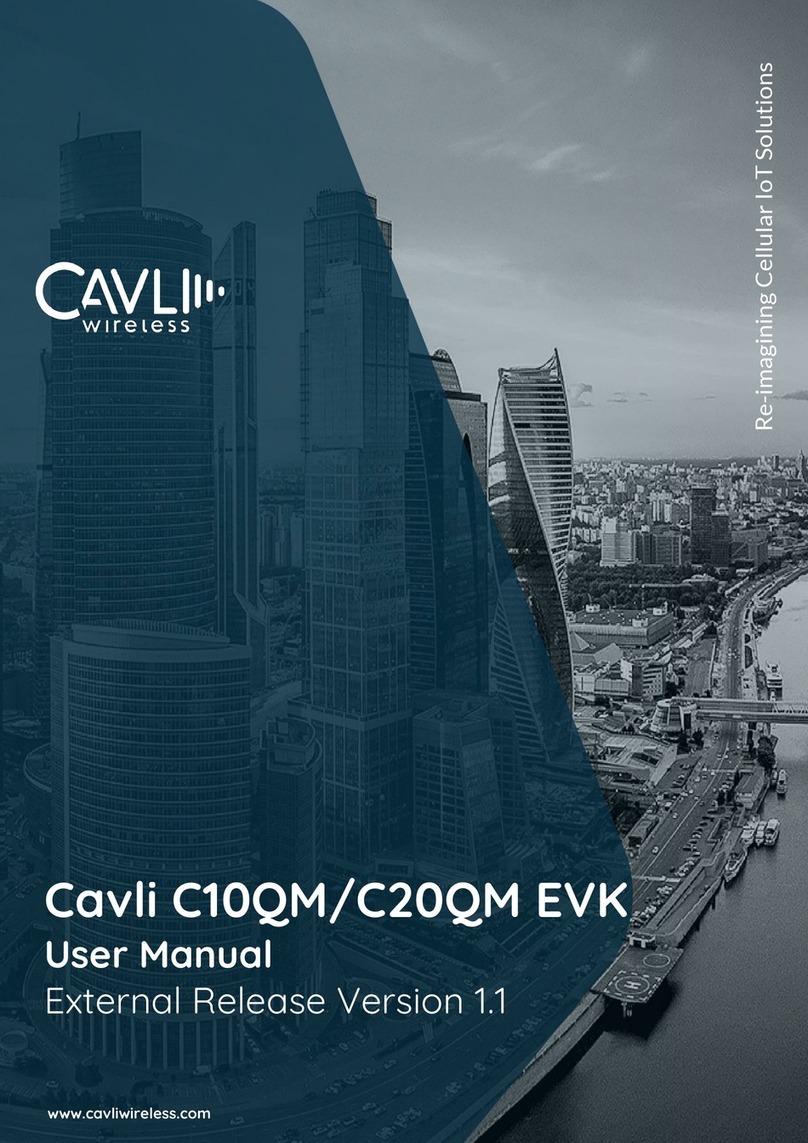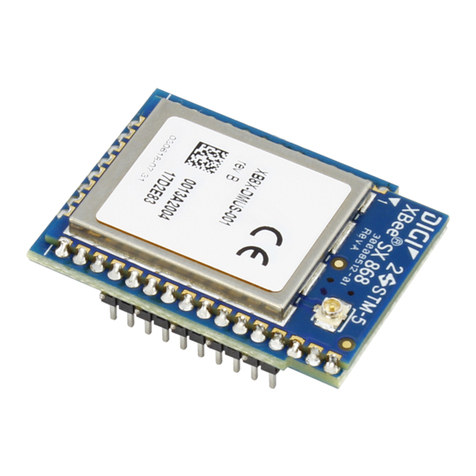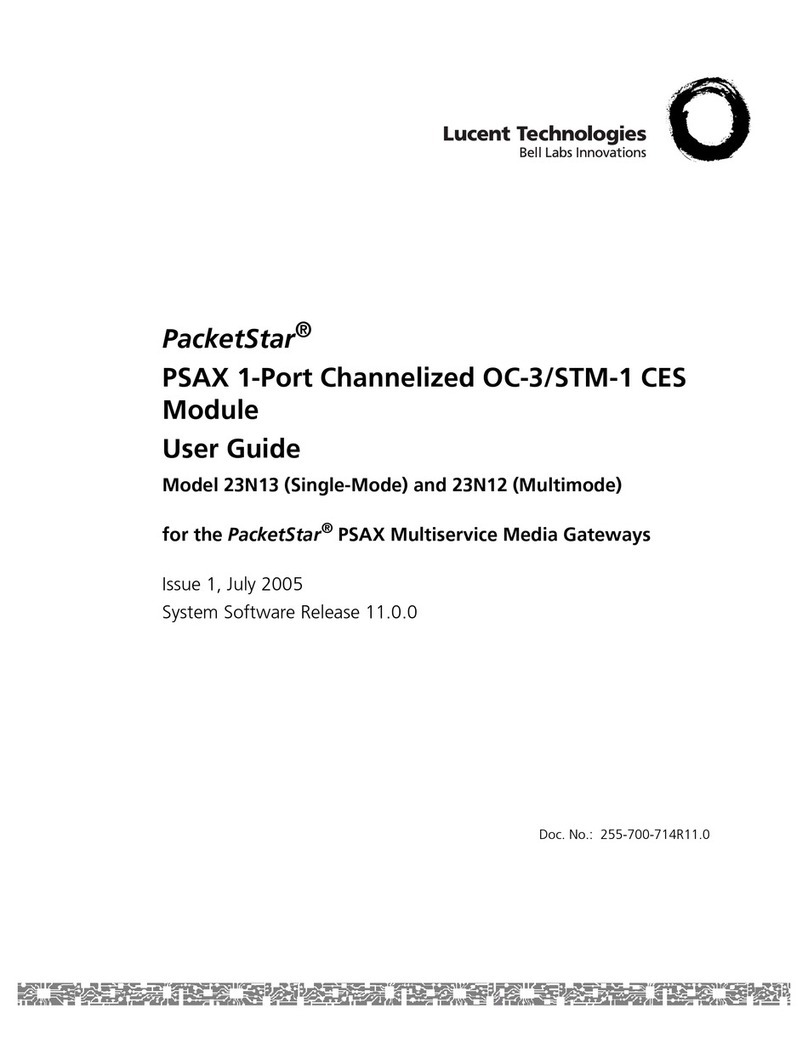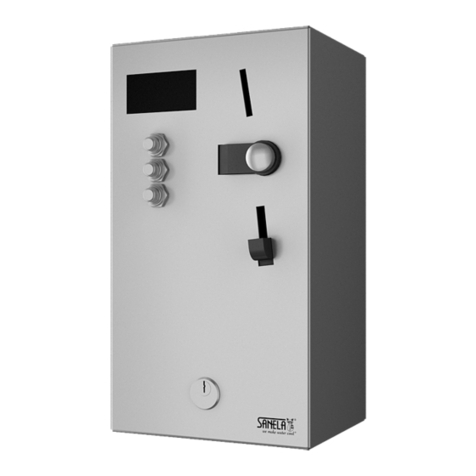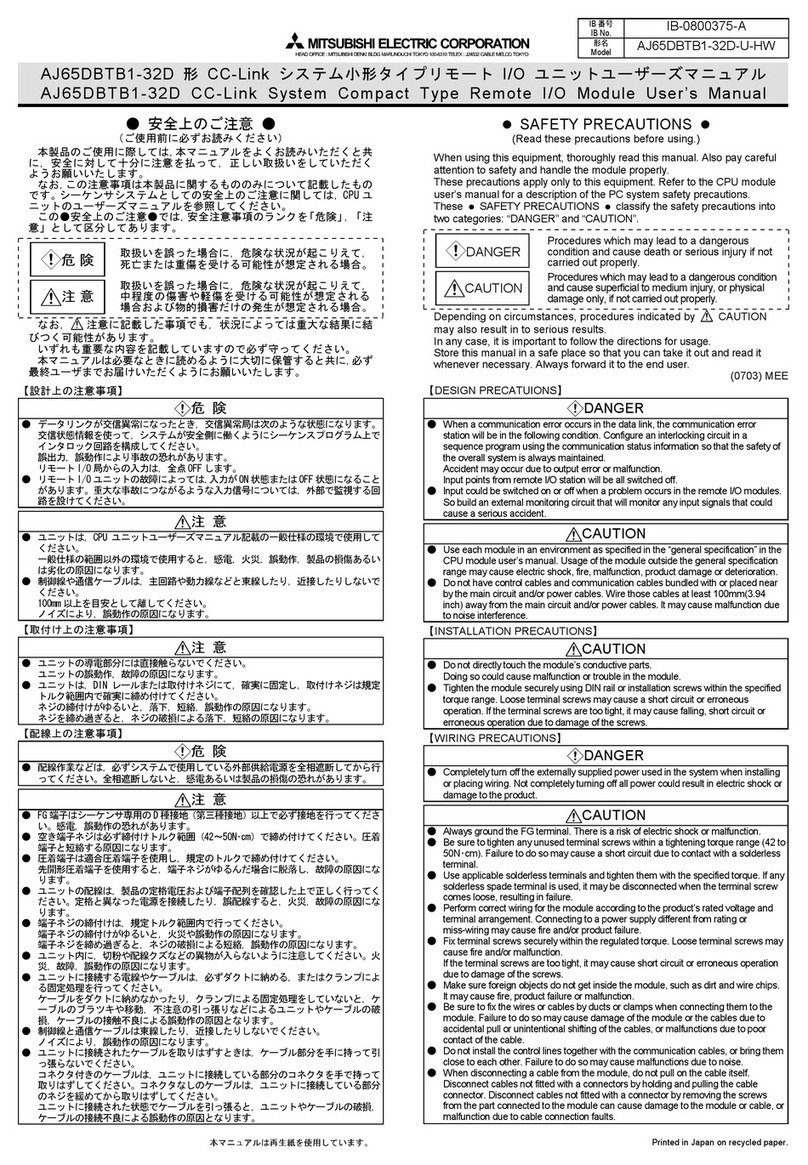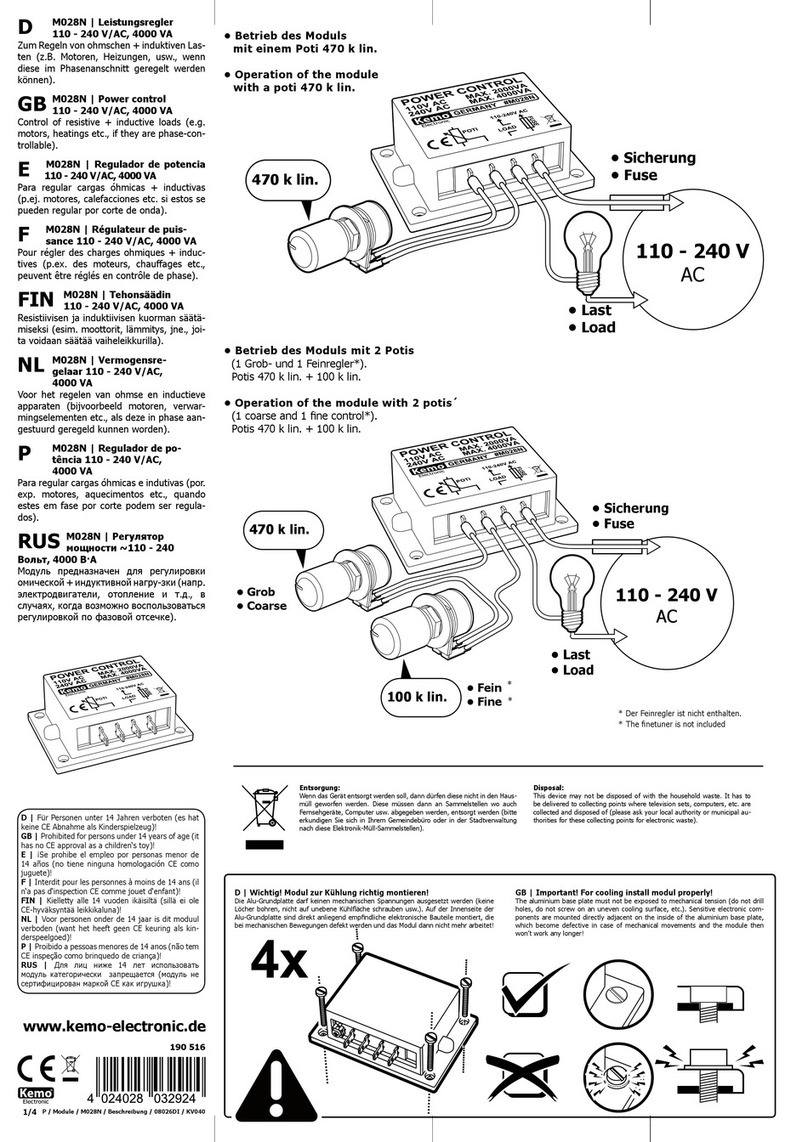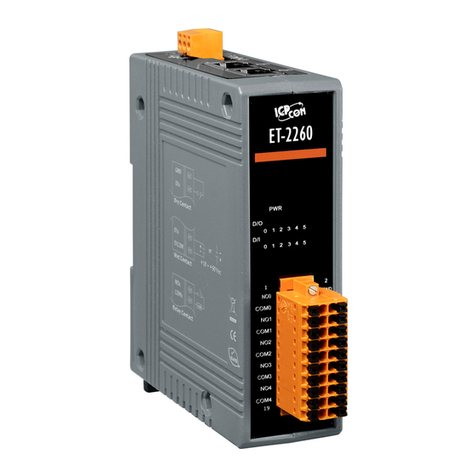Sporlan ESX User manual

The model ESX step motor expansion valve is the newest
addition to Sporlan Valve Division’s complete line of high
quality refrigerant controls. The ESX expansion valve
provides precise flow control for virtually every refrig-
eration, air-conditioning, and heatpump ap-
plication, from basic to complex, and in a
wide range of environments. This step mo-
tor expansion valve is the ideal choice due
to its compatibility with most halocarbon refrigerant systems,
and most step motor controllers. Installation and operation of
the highly reliable ESX is simple and straightforward; enabling
any type system to be more efficient, more versatile, and more
reliable. The model ESX step motor expansion valve provides
maximum system value through precise, energy efficient flow
control.
Features & Benefits Summary
1. Highly reliable direct drive step motor
■ Compatible with bipolar and unipolar type controllers
■ Rugged design
■ No maintenance or re-calibration required
2. Precise 500 step flow resolution
3. Compact, fully hermetic design—no mechanical joints, no leaks
4. “ Dry” stator design
■ 10 position choices - movable and replaceable stator coil
5. Tight shutoff for high efficiency systems
■ Eliminates the need for a separate liquid line solenoid valve
■ Durable needle valve construction for reliable 10 year life
6. Efficient low power design; no holding current required
7. Rapid response; less than 6 seconds full stroke
8. Bi-flow capable for heatpump applications
9. Compatible with nearly all HCFC and HFC refrigerants
Step Motor Valve Function
Step motors accurately achieve and maintain a controlled position making them
ideal actuators for precision flow control valves. Like a conventional DC mo-
tor, the model ESX has a permanent magnet rotor and a stator; however, they
are specially designed for precise positioning, low power, and refrigerant
compatibility.
Bulletin 100-20-2
February 2006
STEP MOTOR EXPANSION VALVE
®

Page 2 / Bulletin 100-20-2
The “dry” stator is constructed with multiple magnetic
pole pairs created by energized wire windings. The term
“dry” is used because the windings of the stator are out-
side the refrigerant envelope. In the ESX stator there are 4
phases (windings) energized sequentially by a step motor
controller that creates a rotating magnetic field. The sta-
tor magnetically couples with the rotor and causes it to turn
in unison with the rotating field. The field rotates either
clockwise or counter-clockwise depending on the sequence
of electrical pulses to each of the 4 phases. The result is a
proportional valve actuator with the ability to achieve a pre-
cise, repeatable position using an electronic signal.
The “wet” rotor is directly linked to a low-friction threaded
“needle” which moves into and out of the valve’s metering
orifice. The term “wet” indicates that the permanent magnet
rotor is located in the hermetic refrigerant environment. As
the rotor rotates step by step, the needle’s distance from the
valve orifice changes incrementally, thus opening or closing
the expansion valve. Valve “steps” are incremental changes
of the rotor position; in the ESX valve, each step is equivalent
to a 3.75° rotation of the rotor. An internal torsion spring lim-
its clockwise and counter-clockwise motion to eliminate the
potential damage due to driving the valve past its full open or
full closed position. The torsion spring absorbs the torque at
the extreme rotational positions and causes the rotor to “slip”
in the magnetic field created by the stator. The ESX valve
incorporates a spring-loaded needle designed to “collapse”
as the valve approaches the full closed position. This novel
feature limits maximum seating force to reduce seat wear
and maximize valve life. The fine pitch thread design of the
needle prevents “back travel” when power is removed. This
specific feature increases efficiency by requiring power only
when a change in valve position is called for, the ESX does
not require continuous power to maintain position. The result
is a highly reliable step motor expansion valve which is pre-
dictable, durable, and energy efficient.
Open Loop Position Control
Step motors utilize open loop type feedback to achieve and
maintain a required valve position. Simply stated, the step
motor controller counts the number of pulses that are sent to
the valve in order to keep track of the valve’s position. In this
way, no direct feedback is required to monitor valve position
and design, function, and cost are greatly simplified. With an
appropriate controller and the ESX step motor valve, a wide
range of system diagnostics are possible.
Valve Operation
Proper positioning of valve opening is achieved by sending
a series of electrical pulses to the ESX stator causing it to
rotate open or closed. There are 500 steps of rotation in the
most common single-phase stepping configuration. Of these
500 steps, 400 steps are in the linear control range as shown
in Figure 2. With 400 steps of resolution, incremental flow
changes of 0.25% of full flow are possible. As few as 40 steps
of resolution can achieve stable, efficient system operation
on many applications. This allows the ESX to be used at just
a fraction of its capacity. The wide range of control possible
with the model ESX allows it to be used down to 10% of its
capacity, or up to 110%. Refer to the capacity tables for proper
sizing for your application, refrigerant, and operating condi-
tions.
As shown in Figure 2, approximately 48 single-phase steps
from full closed are required before the valve orifice begins to
open. Beyond 448 steps, the flow rate does not significantly
change. The usable flow range of the valve is from 48 to 448
steps and is the recommended design range for flow control.
The step motor controller should be configured and scaled to
use 48 single phase steps (from step = 0 position) as the 0%
capacity point, and to use 448 steps (from step = 0 position) as
the 100% capacity point.
The initial opening steps (step = 0 to step = 48) position the
valve in its fully closed position but with varying levels of
seating force. This is due to the spring compression biasing the
needle (See figure 1) against the valve seat. Full seating force
is achieved at the home position (step = 0), which is the fully
overdriven position. It is suggested that in forward flow mode
(flow entering side fitting) driving to step 48 will achieve suf-
ficient seating force in most applications. It is not necessary to
overdrive the valve to step = 0 to achieve full valve closure in
forward flow mode, but it is necessary to achieve full closure
when the valve is flowed in the reverse direction.
Because the valve needle is spring biased, the MOPD (Maxi-
mum Operating Pressure Differential) of the valve in reverse
flow can be significantly lower than in forward flow mode.
The MOPD, in reverse flow mode only, varies with orifice
size and is shown in Table 1. Exceeding the MOPD in reverse
flow does not damage the valve; however, it will result in leak-
age through the valve seat until the pressure difference across
the valve decreases below the MOPD. Maximum MOPD will
always be achieved in forward flow mode.
Stator
TabO-Ring
Washer
OUTLET
INLET
Torsion
Spring
Metering Orifice
Spring
Biased
Needle
“Dry” Stator
“Wet” Rotor
Figure 1 - ESX Internal View

Bulletin 100-20-2 / Page 3
Hysteresis and Power Up
Most thermostatic expansion valves have some level of hys-
teresis due to mechanical limitations in their design; this can
result in varying levels of over and underfeeding as the TEV
searches for the correct position. The ESX, however, does not
experience the same limitations due to its unique design. Con-
sequently, the ESX has almost no hysteresis when combined
with an appropriate controller. The controller maintains a step
count that is referenced to determine valve position. With
proper configuration of the step motor controller, extremely
accurate control can be achieved with flawless predictability
and repeatability.
When the controller sends pulses beyond the fully overdriven
(step = 0) position, the rotor will “slip” and the controller will
no longer control an accurate position. For this reason most
step motor valve controllers are configured with the usable
step range, and an initialization routine to establish “home”
(step = 0) position.
It is necessary for the controller to periodically overdrive the
valve for a minimum of 600 pulses to re-establish the step = 0
position; this routine is typically a pre-programmed controller
feature with some minor configuration necessary by the de-
signer. This will ensure that the controller always uses accu-
rate position information. Additionally, it is necessary, when
recovering from a controller or valve power failure, to over-
drive the valve in the exact same manner to re-establish the
step = 0 position. Failure to perform this reset operation after
a power loss or unexpected over/under drive condition can
result in incorrect valve position information and unpredict-
able valve operation.
Step Motor Valve Operation
Step motor expansion valves are available in two different
types, unipolar and bipolar. The ESX valve is a unipolar (5
wire) type; however, it can be utilized in either unipolar or
bipolar configurations.
ESX Configured as a Unipolar
Step Motor Valve
The ESX unipolar motor utilizes two windings, each with
a center tap (Figure 3). The two windings, plus a common
center tap from each, form the five wire connection common
to unipolar step motors (Orange, Red, Yellow, Black, Gray)
The center tap (Gray) creates four independent phases, there
are four regions with which a magnetic field is produced. The
arrangement and sequence of energizing each of these four
phases causes the field rotation to move the permanent mag-
net rotor (Figure 3). By selectively and sequentially energizing
each stator phase, a magnetic pole (S) is created in the stator
which attracts the opposite permanent magnet pole (N) on the
rotor. To maximize resolution, two adjacent windings can be
energized simultaneously, called half-stepping, to move the
rotor to a region halfway between phases. An electrical logic
diagram is shown in Table 2 to clarify single-phase stepping
and the required selection and sequence for energizing the sta-
tor phases.
The drive circuit for a unipolar step motor is typically the least
complex of step motor controllers. The unipolar control cir-
cuit sequentially energizes each phase, and adjacent phase in
alternating sequence (Table 2).
Half-stepping is used to increase the resolution of the step
motor by doubling the number of regions where the rotor can
be positioned. The diagram below includes both single and
half-step (*) operations required to operate the ESX valve in
a unipolar configuration.
Note: For unipolar operation, only “pull” type stepping is re-
quired (no polarity change) for proper operation. Do not use
“push/pull” stepping (polarity switching) with the ESX valve
in a unipolar configuration.
Phase
Pulse Steps
Rotated O
(Orange) R
(Red) Y
(Yellow) B
(Black)
1 1 Zero HI HI HI
2 *2 Zero Zero HI HI
3 3 HI Zero HI HI
4 *4 HI Zero Zero HI
5 5 HI HI Zero HI
6 *6 HI HI Zero Zero
7 7 HI HI HI Zero
8 *8 Zero HI HI Zero
Note: Center taps at +12V at all times; “Zero” indicates Zero
V. “HI” indicates high impedance of phase. Reverse the se-
quence to rotate in the opposite direction. Only 8 steps shown;
for further rotation, sequence repeats.
Recommended Control Range
Single Phase Step Position
R-22 Mass Flow (lb/hr)
(100 psi ∆P, 100°F liquid)
0
0
100
200
300
400
500
600
700
800
900
50 100 150 200 250 300 350 400 450 500
48
448
ESX-24
ESX-18
ESX-14
Figure 2 - ESX Capacity Chart
Table 1 - ESX MOPD Limits
Table 2 - Unipolar Step Logic
MOPD Forward MOPD Reverse
ESX-14 500 psi 400 psi
ESX-18 500 psi 300 psi
ESX-24 500 psi 125 psi

Page 4 / Bulletin 100-20-2
O
B
–+
1
G
Y
R
G
s
N
Step
Position
O
B
–+
–+
2
G
Y
R
G
s
N
Step
Position
Wiring color code
O: Orange
R: Red
Y: Yellow
B: Black
G: Gray (common center tap)
ESX Configured as a Bipolar
Step Motor Valve
Although strongly suggested that the ESX not be
powered in the bipolar mode, control with bipolar
drives is possible with suitable design.
Bipolar step motor valves utilize a different stator wind-
ing configuration by elimination of the center taps and con-
necting all phases together to form a bridge arrangement.
Connections to the windings are made at the junctions between
the windings, therefore only 4 wires and no separate ground
wire are required. There remain four regions with which a
magnetic field is produced. The polarity of each winding can
be reversed requiring a more complex control circuit than
the unipolar arrangement. Selectively energizing each stator
winding, while also switching polarity during the sequence,
creates the same step motion as the unipolar arrangement.
When using the ESX valve with a bipolar controller, the center
ground tap is not used (must be capped) and the stator is used
as a 24-volt bipolar stator. Resolution is decreased by half be-
cause each controller pulse in a bipolar arrangement moves
two single-phase steps (one two-phase step); a minimum of 2
phases are always energized. When using the model ESX in a
bipolar arrangement, valve capacity is the same, but resolution
is decreased from 500 single-phase steps to 250 two-phase
steps. In this arrangement the center tap is not used; each full
winding serves as two phases operating together with oppos-
ing polarity. Sequence and polarity of each phase winding
connection is shown in the table for 8 two-phase steps.
Phase
Pulse Step
Position
O
(Orange)
R
(Red)
Y
(Yellow)
B
(Black)
1 2 + - HI HI
2 4 - + + -
3 6 HI HI + -
4 8 + - - +
Note: “+” indicates +24V; “-” indicates –24V; “HI” indi-
cates high impedance. Reverse the sequence to rotate in the
opposite direction. Only 8 steps shown; for further rotation,
sequence repeats.
O
B
2
G
Y
R
G
s
N
Step
Position
+ –
O
B
–+
3
G
Y
R
G
N
Step
Position
s
O
B
–+
5
G
Y
R
G
N
Step
Position
s
O
B
–+
–+
4
G
Y
R
G
s
N
Step
Position
O
B
–+
–+
6
G
Y
R
G
N
Step
Position
s
O
B
–+
7
G
Y
R
G
N
Step
Position
s
O
B
–+
–+
8
G
Y
R
G
N
Step
Position
s
Figure 3 - ESX Unipolar Step Sequence
Table 3 - Bipolar Step Logic
O
B
4
G
Y
R
G
s
N
Step
Position
+–
+ –
O
B
6
G
Y
R
G
s
N
Step
Position
+ –
O
B
8
G
Y
R
G
s
N
Step
Position
+ –
+–
Figure 4 - ESX Bipolar Step Sequence

Bulletin 100-20-2 / Page 5
Application
Sporlan Valve Division is not responsible for system design,
any damage arising from faulty system design, or for misap-
plication of its products. If these valves are applied in any
manner other than as described in this bulletin, the Sporlan
warranty is void. Please contact your Sporlan Sales Engineer
for assistance with your specific application. It is the responsi-
bility of the controller manufacturer to provide suitable drive
circuitry and power supply. Sporlan will assist where neces-
sary, but accepts no liability for improper control of the valve.
It is strongly suggested that power be disabled to the valve
when not actively stepping. Conventional initialization rou-
tines, which include overdriving the motor to ascertain the
zero step position are acceptable. Contact Sporlan for more
information.
Selection Procedure
Electric Expansion Valves (EEVs) are one part of a system
used for refrigerant flow control in air conditioning or refrig-
eration applications. The other parts of the system are sensors
and an electronic controller.
The EEV controls the flow of refrigerant entering the direct
expansion (DX) evaporator in response to signals sent by the
controller.
These signals are calculated by the controller from sensor in-
puts. A set of sensors, either two temperature sensors or a pres-
sure transducer and a temperature sensor, are used to measure
superheat. Typical control is based on superheat setpoint but
an additional temperature sensor may be used to measure dis-
charge water or air temperature. This air or water temperature
is controlled directly, as long as superheat remains at a level
to prevent floodback.
The ability of the EEV to control the amount of refrigerant in
the evaporator to allow reaching discharge setpoint while pre-
venting floodback makes the EEV the ideal expansion device
for most air conditioning, chiller, environmental chamber
and refrigeration applications. Some EEV controllers can be
programmed to follow unique control algorithms making the
EEV especially useful for many diverse applications.
The actual selection of ESX valves should be based on infor-
mation generally required for any expansion valve. The fol-
lowing procedure should be used when selecting a Sporlan
EEV.
1. Determine refrigerant to be used. The ESX valves
may be used on most common refrigerants. See selection
tables.
2. Determine capacity required for the valve. This
is normally the evaporator capacity at the desired condi-
tions.
3. Determine pressure drop across valve. Subtract the
evaporating pressure from the condensing pressure. The
condensing pressure used in this calculation should be
the minimum operating condensing pressure of the sys-
tem. From this value, subtract all other pressure losses to
obtain the net pressure drop across the valve. Be sure to
consider all of the following possible sources of pressure
drop: (1) friction losses through refrigeration lines includ-
ing the evaporator and condenser; (2) pressure drop across
liquid line accessories such as a solenoid valve and filter-
drier; (3) static pressure loss (gain) due to the vertical lift
(drop) of the liquid line; (see Table 4) and (4) pressure drop
across a refrigerant distributor, if used. Refer to Bulletin
20-10 for further information on refrigerant distributors.
4. Determine the liquid temperature of the refriger-
ant entering the valve. The EEV capacity tables are
based on a liquid temperature of 100°F (38°C) for R-22,
R-134a, R-404A/R-507 and R-407C. For other liquid tem-
peratures, apply the correction factor given in the tables
for each refrigerant.
5. Select valve from the capacity tables. Select a valve
based on the design evaporating temperature and the avail-
able pressure drop across the valve. Due to improved abil-
ity to follow load, Sporlan EEVs provide 10% to 110% of
nominal capacity listed in the capacity tables. Be sure to
apply the appropriate liquid temperature correction factor
to the valve ratings shown in the tables. Once the desired
valve capacity has been located, determine the valve mod-
el from the first column of the tables. On multiple evapo-
rator systems, select each valve on the basis of individual
evaporator capacity.
Selection Example:
Refer to Figure 5
Refrigerant: R-134a
Condensing Temperature: 133°F
Liquid Temperature: 80°F
Evaporator Temperature: 40°F
Liquid Line Loss: 7 psi
∆P Distributor and Tubes: 35 psi
Evaporator Load: 2.5 tons
Condensing Pressure (psig): 211
Liquid Line Loss (Estimates): - 7
Distributor and Tubes: -35
Evaporator Pressure (psi): -69
∆P across EEV: 100
R-134a, 80°F Liquid Correction Factor
from Table: 1.19
ESX-18 2.1 tons x 1.19 = 2.5 tons
ESX-24 4.3 tons x 1.19 = 5.1 tons
Select an ESX 18 from capacity table.
*See Sporlan Bulletin 20-10 for pressure drop data as related
to percent loading.

Page 6 / Bulletin 100-20-2
Table 4 - Vertical Lift Pressure Drop
1.51 Ø1.92
0.87
0.5
0.20
0.18
0.96
2.54
2.63
1.00
4.44
0.97
1/2"
ODF
3/8"ODF
or
1/2"ODF
Standard
Flow
Pattern
R-134a
Valve
Type
Nominal
Capacity
(tons)
40°F
Pressure Drop Across Valve (psi)
40 60 80 100 120 140
ESX-14 1.5 0.8 1.0 1.1 1.2 1.4 1.5
ESX-18 2 1.3 1.6 1.9 2.1 2.3 2.5
ESX-24 3.5 2.7 3.4 3.9 4.3 4.8 5.1
B C
D
A
Figure 5 - Capacity Table Example
Liquid Temperature Correction Factors
°F (Liquid Line Temp) 40 50 60 70 80 90
R-134a (Multiplier) 1.44 1.37 1.31 1.25 1.19 1.13
E
Figure 6 - ESX External View
Refrigerant
Vertical Lift Pressure Drop
20 ft.
(psi)
6 m.
(Bar)
40 ft.
(psi)
12 m.
(Bar)
60 ft.
(psi)
18 m.
(Bar)
134a 10 0.7 20 1.4 30 2.0
22 9.9 0.7 20 1.3 30 2.0
407C 9.4 0.6 19 1.3 28 1.9
404A 8.5 0.6 17 1.2 25 1.7
507 8.5 0.6 17 1.2 25 1.7
410A 8.6 0.6 17 1.2 26 1.8
A: Evaporator Temperature/Pressure
B: Pressure Drop
C: Design System Capacity
D: Valve Selection
E: Liquid Temperature Correction Factor
Nomenclature (Example):
ESX -14 B
Valve Model Orifice Diameter Connections
Electronic 14 = 1.4 mm 5/16 x 5/16 ODF
Step Motor 18 = 1.8 mm A 3/8 x 3/8 ODF
eXpansion Valve 24 = 2.4 mm B 3/8 x 1/2 ODF
ESX Technical Specifications
Device Description
4 phase, 24 pole, unipolar, permanent magnet step
motor expansion valve for halocarbon refrigerants
Actuator Type
Dry stator: replaceable, rotatable, 10 position
Wet rotor: fully hermetic body
Valve Orifice Sizes
0.055” (1.4 mm): 1.5 tons R-22
0.071” (1.8 mm): 3.0 tons R-22
0.094” (2.4 mm): 5.0 tons R-22
Construction
Stator: Copper, nylon
Body: Brass, copper, stainless steel
Compatible Refrigerants
R-22, R-134a, R-404A, R-407C, R-507, R-410A
Compatible Oils
Mineral, polyolester, alkylbenzene
Resolution
500±20 steps; 0.104” (2.64 mm) travel
Step Rate
30 pulse/sec minimum to 83.5 pulse/sec maximum
Full Motion Transit Time
16.7 sec @ 30 pulse/sec
6 sec @ 83.5 pulse/sec
Valve Shutoff
140 cc/min @ 150 psid (10.3 Bar)
Metal/metal seating
Over/under drive protected
Stator Voltage
12 VDC ±10%
Power
4 watts nominal during transit
5.8 watts maximum
No holding power required
Stator Insulation
Class E; 500 V no dielectric breakdown
Flow Path/Connections
90° flow pattern; biflow capable
Extended copper connections
Installation orientation
Vertical to horizontal recommended
MOPD
500 psid (34.5 Bar) forward flow (side inlet)
See Table 1 for reverse flow (bottom inlet)
Max. Working Pressure
650 psig (44.8 Bar)
Burst Pressure
3250 psig (224 Bar)
Media Temperature
-40°F to 155°F (-40°C to 70°C)
Ambient / Storage Temperature
-25°F to 140°F (-30°C to 60°C)
Minimum Life
250,000 CYCLES
Corrosion Resistance
100 hr. ASTM B-117 salt spray
Weights
Body: 0.17 lb (77 g)
Stator: 0.34 lb (154 g); without cable
Phase Resistance
46± 4 Ohms each Phase to common (gray) wire

Bulletin 100-20-2 / Page 7
R-22
Valve
Type
Nominal
Capacity
(tons)
40°F 20°F 0°F
Pressure Drop Across Valve (psi)
50 75 100 125 150 175 200 50 75 100 125 150 175 200 75 100 125 150 175 200 225
ESX-14 1.5 0.6 1.1 1.3 1.5 1.6 1.8 1.9 0.9 1.1 1.3 1.4 1.6 1.7 1.8 1.1 1.3 1.4 1.5 1.7 1.8 1.9
ESX-18 2.5 1.0 1.9 2.3 2.5 2.8 3.0 3.2 1.6 1.9 2.2 2.4 2.7 2.9 3.1 1.8 2.1 2.4 2.6 2.8 3.0 3.2
ESX-24 5 2.14 4.0 4.6 5.2 5.7 6.1 6.5 3.2 3.9 4.5 5.0 5.5 5.9 6.4 3.8 4.4 4.9 5.3 5.8 6.2 6.5
Valve
Type
Nominal
Capacity
(tons)
-10°F -20°F -40°F
Pressure Drop Across Valve (psi)
100 125 150 175 200 225 250 125 150 175 175 200 225 250 100 125 150 175 200 225 250
ESX-14 1.5 1.4 1.5 1.6 1.7 1.9 2.0 2.0 1.4 1.5 1.6 1.7 1.8 1.9 1.9 1.2 1.3 1.4 1.5 1.7 1.8 1.9
ESX-18 2.5 2.3 2.6 2.8 3.0 3.1 3.3 3.3 2.3 2.5 2.7 2.9 3.1 3.3 3.3 2.0 2.2 2.4 2.6 2.8 3.0 3.1
ESX-24 5 4.8 5.3 5.7 6.1 6.4 6.8 6.8 4.7 5.2 5.6 6.0 6.3 6.7 6.7 4.1 4.6 5.0 5.4 5.8 6.1 6.4
R-134a
Valve
Type
Nominal
Capacity
(tons)
40°F 20°F 0°F
Pressure Drop Across Valve (psi)
40 60 80 100 120 140 160 60 80 100 120 140 160 180 60 80 100 120 140 160 180
ESX-14 1 0.8 1.0 1.1 1.2 1.4 1.5 1.6 0.9 1.1 1.2 1.3 1.4 1.5 1.6 0.9 1.0 1.1 1.2 1.3 1.4 1.5
ESX-18 2 1.3 1.6 1.9 2.1 2.3 2.5 2.7 1.6 1.8 2.0 2.2 2.4 2.6 2.7 1.5 1.7 1.9 2.1 2.3 2.4 2.6
ESX-24 3.5 2.7 3.4 3.9 4.3 4.8 5.1 5.5 3.2 3.7 4.1 4.5 4.9 5.3 5.6 3.1 3.5 4.0 4.3 4.7 5.0 5.3
R-404A
Valve
Type
Nominal
Capacity
(tons)
40°F 20°F 0°F
Pressure Drop Across Valve (psi)
50 75 100 125 150 175 200 50 75 100 125 150 175 200 75 100 125 150 175 200 225
ESX-14 1 0.6 0.8 0.9 1.0 1.1 1.2 1.2 0.6 0.7 0.8 0.9 1.0 1.1 1.2 0.7 0.8 0.9 1.0 1.0 1.1 1.2
ESX-18 1.5 1.1 1.3 1.5 1.7 1.8 2.0 2.1 1.0 1.2 1.4 1.6 1.7 1.9 2.0 1.2 1.3 1.5 1.6 1.8 1.9 2.0
ESX-24 3 2.2 2.6 3.1 3.4 3.7 4.0 4.3 2.1 2.5 2.9 3.2 3.6 3.8 4.1 2.4 2.7 3.1 3.3 3.6 3.9 4.1
Valve
Type
Nominal
Capacity
(tons)
-10°F -20°F -40°F
Pressure Drop Across Valve (psi)
100 125 150 175 200 225 250 125 150 175 175 200 225 250 100 125 150 175 200 225 250
ESX-14 1 0.9 0.9 1.0 1.1 1.1 1.2 1.2 0.8 0.9 1.0 1.0 1.1 1.2 1.2 0.7 0.8 0.8 0.9 1.0 1.0 1.1
ESX-18 1.5 1.4 1.6 1.7 1.8 1.9 2.0 2.0 1.4 1.5 1.7 1.8 1.9 2.0 2.0 1.8 1.3 1.4 1.5 1.6 1.7 1.8
ESX-24 3 3.0 3.2 3.5 3.7 4.0 4.2 4.2 2.9 3.1 3.4 3.6 3.8 4.1 4.1 2.4 2.6 2.9 3.1 3.3 3.5 3.7
Liquid Temperature Correction Factors
°F 40 50 60 70 80 90 100 110 120 130 140
R-22 1.32 1.27 1.22 1.16 1.11 1.06 1.00 0.94 0.90 0.84 0.78
R-134a 1.44 1.37 1.31 1.25 1.19 1.13 1.06 1.00 0.94 0.87 0.81
R-404A 1.53 1.45 1.36 1.27 1.18 1.09 1.00 0.93 0.84 0.74 0.63
°F Capacity Ratings R-22, R-134a, R-404A
Tons at Evaporator Temperature (Based on 100°F Liquid)
Model ESX valves are designed to cover an operating range from 10% of table capacity up to 110% of table capacity. Shaded areas are
standard rating conditions.
NOTE: Correction factor closest to actual system liquid temperatures may be
used, e.g. 48°F actual liquid use 50°F factor. Based on 0°F evaporator, variation
across evaporating range of -40°F to 40°F (-40°C to 5°C) is insignificant.
°F Capacity Ratings

Page 8 / Bulletin 100-20-2
R-410A
Valve
Type
Nominal
Capacity
(tons)
40°F 20°F 0°F
Pressure Drop Across Valve (psi)
100 120 160 200 240 280 320 100 120 160 200 240 280 320 100 120 160 200 240 280 320
ESX-14 1.5 1.3 1.4 1.6 1.8 2.0 2.1 2.3 1.2 2.1 2.3 1.4 1.6 1.7 1.9 1.2 1.3 1.5 1.7 1.9 2.0 2.1
ESX-18 2.5 2.1 2.3 2.7 3.0 3.3 3.6 3.9 2.1 2.3 2.6 3.0 3.2 3.5 3.8 2.0 2.2 2.6 2.9 3.1 3.4 3.6
ESX-24 5.5 4.4 4.8 5.6 6.2 6.8 7.4 7.9 4.3 7.4 7.9 4.7 5.4 6.1 6.6 4.2 4.6 5.3 5.9 6.5 7.0 7.5
R-407C
Valve
Type
Nominal
Capacity
(tons)
40°F 20°F 0°F
Pressure Drop Across Valve (psi)
50 75 100 125 150 175 200 50 75 100 125 150 175 200 75 100 125 150 175 200 225
ESX-14 2 0.8 1.5 2.0 2.2 2.4 2.6 2.8 0.8 1.0 1.1 1.3 1.4 1.5 1.6 0.9 1.1 1.2 1.3 1.4 1.5 1.6
ESX-18 3.5 2.1 2.6 3.3 3.7 4.1 4.4 4.7 1.4 1.7 1.9 2.2 2.4 2.6 2.7 1.6 1.8 2.1 2.3 2.4 2.6 2.8
ESX-24 7 3.0 5.3 6.9 7.7 8.4 9.1 9.7 2.8 3.4 4.0 4.4 4.9 5.2 5.6 3.3 3.8 4.2 4.6 5.0 5.4 5.7
R-507
Valve
Type
Nominal
Capacity
(tons)
40°F 20°F 0°F
Pressure Drop Across Valve (psi)
50 75 100 125 150 175 200 50 75 100 125 150 175 200 75 100 125 150 175 200 225
ESX-14 1 0.6 0.8 0.8 0.9 1.0 1.1 1.1 0.6 0.7 0.8 0.9 1.0 1.0 1.1 0.6 0.7 0.8 0.9 1.0 1.1 1.1
ESX-18 1.5 1.0 1.3 1.4 1.6 1.7 1.9 2.0 1.0 1.2 1.3 1.5 1.6 1.8 1.9 1.1 1.3 1.4 1.5 1.7 1.8 1.9
ESX-24 3 2.0 2.6 2.9 3.3 3.6 3.8 4.1 2.0 2.4 2.8 3.1 3.4 3.6 3.9 2.2 2.6 2.9 3.2 3.4 3.7 3.9
Valve
Type
Nominal
Capacity
(tons)
-10°F -20°F -40°F
Pressure Drop Across Valve (psi)
100 125 150 175 200 225 250 100 125 150 175 200 225 250 100 125 150 175 200 225 250
ESX-14 1 0.8 0.9 1.0 1.0 1.1 1.1 1.1 0.7 0.8 0.9 0.9 1.0 1.0 1.1 0.7 0.7 0.8 0.9 0.9 1.0 1.5
ESX-18 2 1.4 1.5 1.6 1.7 1.8 1.8 1.9 1.2 1.3 1.4 1.6 1.7 1.8 1.9 1.1 1.2 1.3 1.5 1.6 1.7 2.6
ESX-24 3.5 2.8 3.1 3.3 3.6 3.8 3.8 4.0 2.4 2.7 3.0 3.2 3.4 3.6 3.8 2.3 2.5 2.8 3.0 3.2 3.4 5.3
Liquid Temperature Correction Factors
°F 40 50 60 70 80 90 100 110 120 130 140
R-407C 1.42 1.35 1.28 1.21 1.14 1.07 1.00 0.93 0.85 0.77 0.69
R-410A 1.43 1.36 1.29 1.22 1.15 1.08 1.00 0.95 0.87 0.79 0.69
R-507 1.53 1.45 1.36 1.27 1.18 1.09 1.00 0.93 0.84 0.74 0.63
°F Capacity Ratings R-407C, R-410A, R-507
Tons at Evaporator Temperature (Based on 100°F Liquid)
Model ESX valves are designed to cover an operating range from 10% of table capacity up to 110% of table capacity. Shaded areas are
standard rating conditions.
NOTE: Correction factor closest to actual system liquid temperatures may be
used, e.g. 48°F actual liquid use 50°F factor. Based on 0°F evaporator, variation
across evaporating range of -40°F to 40°F (-40°C to 5°C) is insignificant.
°F Capacity Ratings

Bulletin 100-20-2 / Page 9
R-22
Valve
Type
Nominal
Capacity
(kW)
5°C -10°C -20°C
Pressure Drop Across Valve (psi)
4 6 8 10 12 14 16 4 6 8 10 12 14 16 6 8 10 12 14 16 18
ESX-14 4.5 3.4 4.1 4.8 5.3 5.8 6.3 6.7 3.2 4.0 4.6 5.1 5.6 6.1 6.5 3.9 4.5 5.0 5.5 5.9 6.3 6.7
ESX-18 7 5.7 7.0 8.1 9.0 9.9 10.7 11.4 5.5 6.7 7.8 8.7 9.5 10.3 11.0 6.5 7.5 8.4 9.2 10.0 10.7 11.3
ESX-24 15 11.7 14.3 16.5 18.5 20.3 21.9 23.4 11.3 13.8 15.9 17.8 19.5 21.1 22.5 13.4 15.5 17.3 19.0 20.5 21.9 23.2
Valve
Type
Nominal
Capacity
(kW)
-30°C -40°C
Pressure Drop Across Valve (psi)
8 10 12 14 16 18 20 8 10 12 14 16 18 20
ESX-14 4.5 4.3 4.8 5.3 5.7 6.1 6.5 6.9 4.2 4.7 5.1 5.6 5.9 6.3 6.6
ESX-18 7 7.3 8.2 9.0 9.7 10.4 11.0 11.6 7.1 8.0 8.7 9.4 10.1 10.7 11.3
ESX-24 15 15.1 16.9 18.5 19.9 21.3 22.6 23.8 14.6 16.3 17.9 19.3 20.7 21.9 23.1
R-134a
Valve
Type
Nominal
Capacity
(kW)
5°C -10°C -20°C
Pressure Drop Across Valve (psi)
4 6 8 10 12 14 16 4 6 8 10 12 14 16 6 8 10 12 14 16 18
ESX-14 4.5 3.1 3.8 4.4 5.0 5.4 5.9 6.3 2.9 3.6 4.2 4.7 5.1 5.5 5.9 3.4 4.0 4.4 4.9 5.3 5.6 6.0
ESX-18 7.5 5.3 6.5 7.5 8.4 9.2 9.9 10.6 5.0 6.1 7.1 7.9 8.6 9.3 10.0 5.8 6.7 7.5 8.3 8.9 9.5 10.1
ESX-24 15.5 10.9 13.4 15.4 17.2 18.9 20.4 21.8 10.2 12.5 14.5 16.2 17.7 19.1 20.5 12.0 13.8 15.5 16.9 18.3 19.6 20.7
R-404A
Valve
Type
Nominal
Capacity
(kW)
5°C -10°C -20°C
Pressure Drop Across Valve (psi)
4 6 8 10 12 14 16 4 6 8 10 12 14 16 6 8 10 12 14 16 18
ESX-14 3 2.2 2.7 3.1 3.5 3.9 4.2 4.4 2.0 2.5 2.9 3.2 3.5 3.8 4.1 2.8 3.1 3.4 3.7 3.9 4.1 2.6
ESX-18 5 3.8 4.6 5.3 6.0 6.5 7.1 7.5 3.5 4.3 4.9 5.5 6.0 6.5 6.9 4.7 5.2 5.7 6.2 6.6 7.0 4.4
ESX-24 10 7.7 9.5 10.9 12.2 13.4 14.5 15.5 7.1 8.7 10.1 11.3 12.3 13.3 14.2 9.6 10.7 11.8 12.7 13.6 14.4 9.0
Valve
Type
Nominal
Capacity
(kW)
-30°C -40°C
Pressure Drop Across Valve (psi)
8 10 12 14 16 18 20 8 10 12 14 16 18 20
ESX-14 3 2.6 2.9 3.2 3.4 3.7 3.9 4.1 2.4 2.7 3.0 3.2 3.4 3.6 3.8
ESX-18 5 4.4 4.9 5.4 5.8 6.2 6.6 7.0 4.1 4.6 5.0 5.4 5.8 6.2 6.5
ESX-24 10 9.0 10.1 11.1 11.9 12.8 13.5 14.3 8.4 9.4 10.3 11.1 11.9 12.6 13.3
Liquid Temperature Correction Factors
°C 4 10 16 21 27 32 38 43 49 54 60
R-22 1.32 1.27 1.22 1.16 1.11 1.06 1.00 0.94 0.90 0.84 0.78
R-134a 1.44 1.37 1.31 1.25 1.19 1.13 1.06 1.00 0.94 0.87 0.81
R-404A 1.53 1.45 1.36 1.27 1.18 1.09 1.00 0.93 0.84 0.74 0.63
°C Capacity Ratings R-22, R-134a, R-404A
kW at Evaporator Temperature (Based on 38°C Liquid)
Model ESX valves are designed to cover an operating range from 10% of table capacity up to 110% of table capacity.
NOTE: Correction factor closest to actual system liquid temperatures may be
used, e.g. 5°C actual liquid use 4°C factor. Based on 0°C evaporator, variation
across evaporating range of -40°C to 5°C (-40°F to 40°F) is insignificant.
°C Capacity Ratings

Page 10 / Bulletin 100-20-2
R-410A
Valve
Type
Nominal
Capacity
(kW)
5°C -10°C -20°C
Pressure Drop Across Valve (psi)
10 12 14 16 18 20 22 10 12 14 16 18 20 22 10 12 14 16 18 20 22
ESX-14 5 5.0 5.5 6.0 6.4 6.7 7.1 7.6 4.9 5.3 5.8 6.1 6.5 6.9 7.3 4.7 5.2 5.6 6.0 6.3 6.7 7.1
ESX-18 9 8.5 9.3 10.1 10.8 11.4 12.1 12.8 8.2 9.0 9.8 10.4 11.1 11.7 12.4 8.0 8.8 9.5 10.1 10.8 11.3 12.1
ESX-24 18 17.5 19.2 20.7 22.1 23.5 24.7 26.4 16.9 18.5 20.0 21.4 22.7 23.9 25.5 16.5 18.0 19.5 20.8 22.1 23.3 24.8
R-407C
Valve
Type
Nominal
Capacity
(kW)
5°C -10°C -20°C
Pressure Drop Across Valve (psi)
4 6 8 10 12 14 16 4 6 8 10 12 14 16 6 8 10 12 14 16 18
ESX-14 4 3.1 3.8 4.4 4.9 5.4 5.8 6.2 2.9 3.6 4.1 4.6 5.0 5.4 5.8 3.4 4.0 4.4 4.9 5.2 5.6 5.9
ESX-18 7 5.2 6.4 7.4 8.3 9.1 9.8 10.5 4.9 6.0 7.0 7.8 8.5 9.2 9.8 5.8 6.7 7.5 8.2 8.9 9.5 10.1
ESX-24 14 10.7 13.2 15.2 17.0 18.6 20.1 21.5 10.1 12.4 14.3 16.0 17.5 18.9 20.2 11.9 13.8 15.4 16.9 18.2 19.5 20.7
R-507
Valve
Type
Nominal
Capacity
(kW)
5°C -10°C -20°C
Pressure Drop Across Valve (psi)
4 6 8 10 12 14 16 4 6 8 10 12 14 16 6 8 10 12 14 16 18
ESX-14 3 2.2 2.7 3.1 3.5 3.8 4.1 4.4 2.0 2.5 2.8 3.2 3.5 3.8 4.0 2.4 2.7 3.0 3.3 3.6 3.8 4.1
ESX-18 5 3.7 4.5 5.2 5.9 6.4 6.9 7.4 3.4 4.2 4.8 5.4 5.9 6.4 6.8 4.0 4.6 5.2 5.6 6.1 6.5 6.9
ESX-24 10 7.6 9.3 10.7 12.0 13.2 14.2 15.2 7.0 8.6 9.9 11.1 12.1 13.1 14.0 8.2 9.5 10.6 11.6 12.5 13.4 14.2
Valve
Type
Nominal
Capacity
(kW)
-30°C -40°C
Pressure Drop Across Valve (psi)
8 10 12 14 16 18 20 8 10 12 14 16 18 20
ESX-14 3 2.5 2.8 3.1 3.4 3.6 3.8 4.0 2.4 2.7 2.9 3.2 3.4 3.6 3.8
ESX-18 5 4.3 4.8 5.3 5.7 6.1 6.5 6.8 4.0 4.5 5.0 5.3 5.7 6.1 6.4
ESX-24 10 8.8 9.9 10.8 11.7 12.5 13.3 14.0 8.3 9.3 10.2 11.0 11.7 12.4 13.1
Liquid Temperature Correction Factors
°C 4 10 16 21 27 32 38 43 49 54 60
R-407C 1.42 1.35 1.28 1.21 1.14 1.07 1.00 0.93 0.85 0.77 0.69
R-410A 1.43 1.36 1.29 1.22 1.15 1.08 1.00 0.95 0.87 0.79 0.69
R-507 1.53 1.45 1.36 1.27 1.18 1.09 1.00 0.93 0.84 0.74 0.63
°C Capacity Ratings R-407C, R-410A, R-507
kW at Evaporator Temperature (Based on 38°C Liquid)
Model ESX valves are designed to cover an operating range from 10% of table capacity up to 110% of table capacity.
NOTE: Correction factor closest to actual system liquid temperatures may be
used, e.g. 5°C actual liquid use 4°C factor. Based on 0°C evaporator, variation
across evaporating range of -40°C to 5°C (-40°F to 40°F) is insignificant.
°C Capacity Ratings

Bulletin 100-20-2 / Page 11
*Gray wire for ESX only.
DI1
1-
1S
1+
R = Red
G = Green
W = White
B = Black
TS2 - Temp. Sensor 2
TS1 - Temp. Sensor 1
PB1 PB2
8.8.
Temperature
Sensor
SER, ESX,
SEI, SEH
TS2TS1 B W G R 1+ 1S 1- DI1
24 VAC
24 VAC
40 VA
Transformer
Pumpdown
Relay
(optional)
Pressure
Transducer
*
Evaporator
DI1
1-
1S
1+
R = Red
G = Green
W = White
B = Black
TS2 - Temp. Sensor 2
TS1 - Temp. Sensor 1
PB1 PB2
8.8.
Temperature
Sensor
Temperature
Sensor
Outlet - Liquid or Air
ESX, SER,
SEI, SEH
TS2TS1 B W G R 1+ 1S 1- DI1
24 VAC
24 VAC
40 VA
Transformer
Pumpdown
Relay
(optional)
Pressure
Transducer
*Gray wire for ESX only.
*
Superheat Controller Wiring Schematic
Refrigeration P/T or Subcooler Controller Wiring Schematic

Page 12 / Bulletin 100-20-2
Printed in U.S. of A. © Copyright 2006 by Parker Hannifin Corporation, Washington, MO 206
Chiller Controller Wiring Schematic
Evaporator
Temperature
Sensor
ESX, SER,
SEI, SEH
TS4TS3 R G W B 2- 2S 2+ DI2
Pressure
Transducer
Evaporator
Valve 1
Valve 2
DI1
1-
1S
1+
R = Red
G = Green
W = White
B = Black
TS2 - Temp. Sensor 2
TS1 - Temp. Sensor 1
TS4 - Temp. Sensor 4
TS3 - Temp. Sensor 3
PB1 PB2
8.8.
Temperature
Sensor
SER, ESX,
SEI, SEH
TS2TS1 B W G R 1+ 1S 1- DI1
24 VAC
24 VAC
40 VA
Transformer
Pumpdown
Relay
(optional)
Pressure
Transducer
Valve 2 connections on
left block when used
*Gray wire for ESX only.
*
*
Table of contents
Other Sporlan Control Unit manuals

Sporlan
Sporlan SDR-4 Quick guide
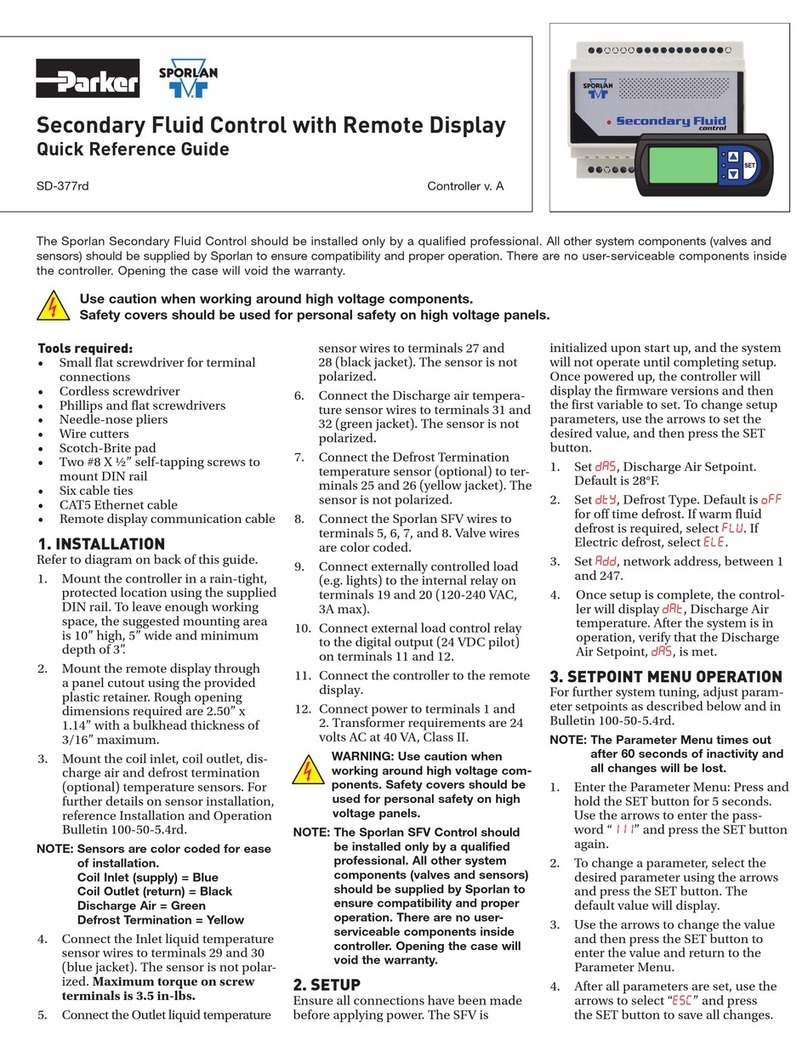
Sporlan
Sporlan Secondary Fluid Control User manual

Sporlan
Sporlan OROA-5 Installation and maintenance instructions
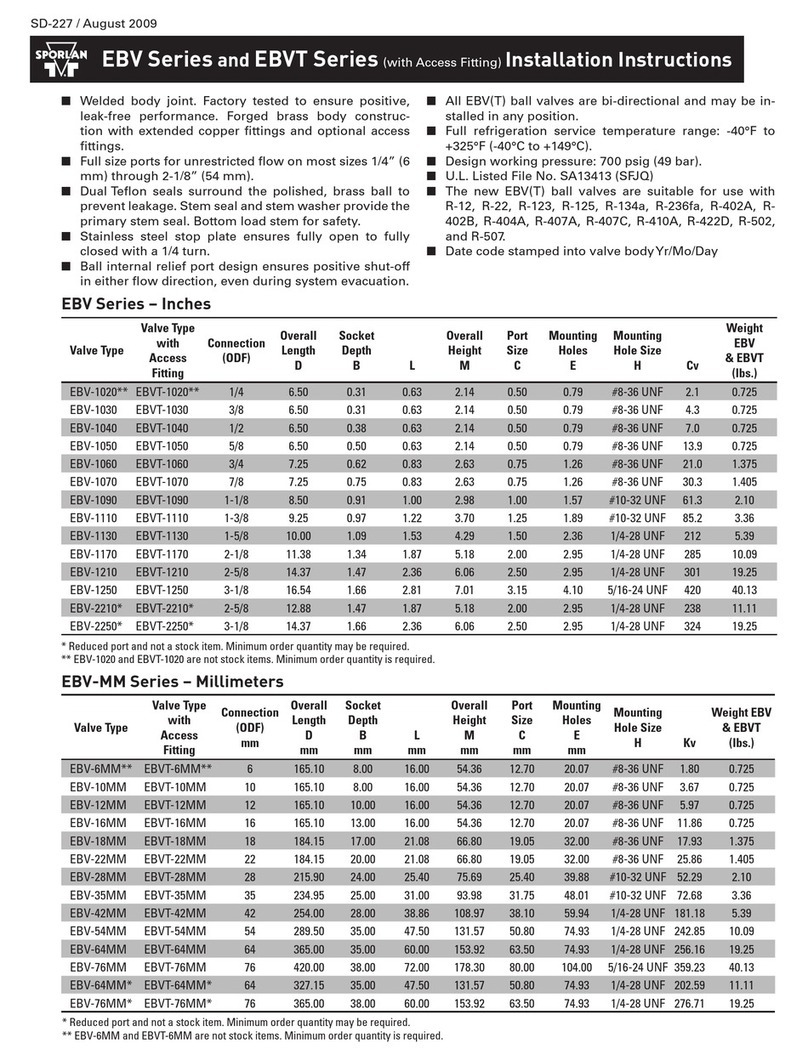
Sporlan
Sporlan EBV Series User manual
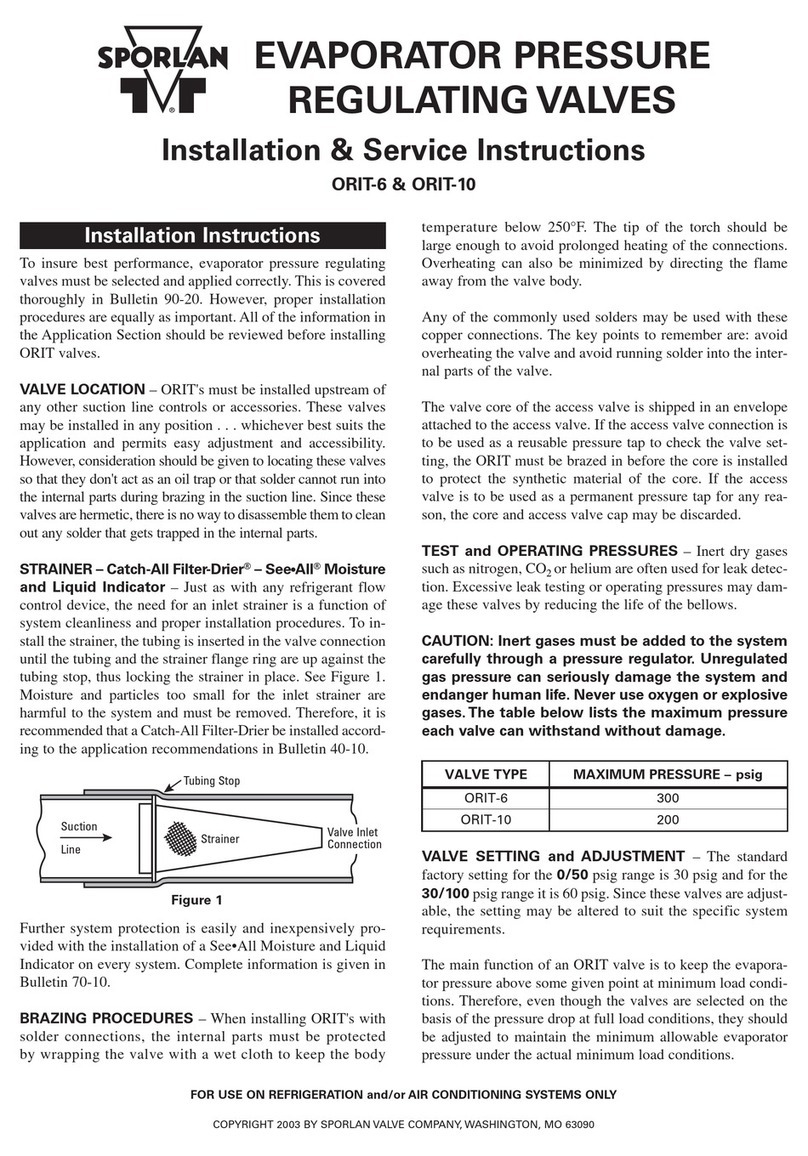
Sporlan
Sporlan ORIT-10 Installation and maintenance instructions
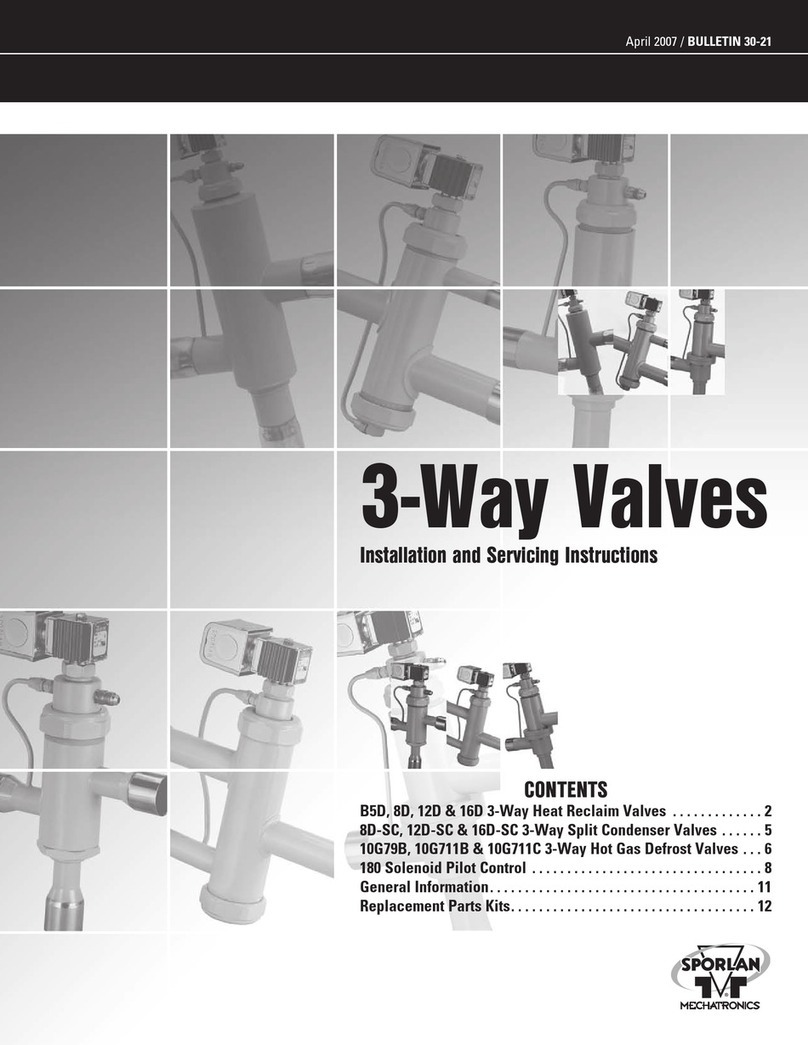
Sporlan
Sporlan B5D User guide
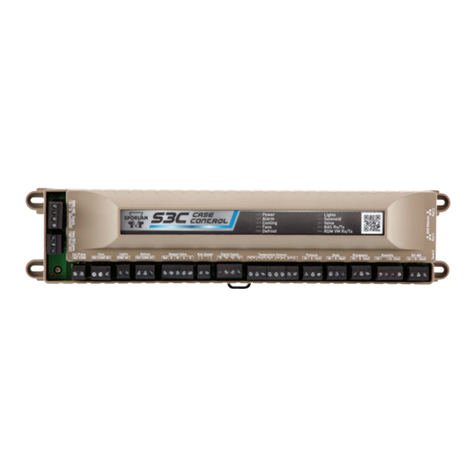
Sporlan
Sporlan Parker S3C User guide

Sporlan
Sporlan ORIT-12 Installation and maintenance instructions
Popular Control Unit manuals by other brands
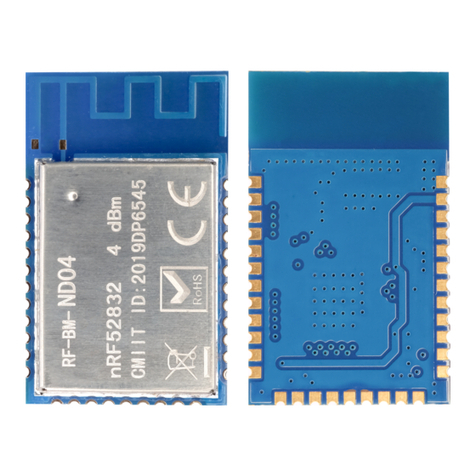
RF-Star
RF-Star RF-BM-ND04 manual
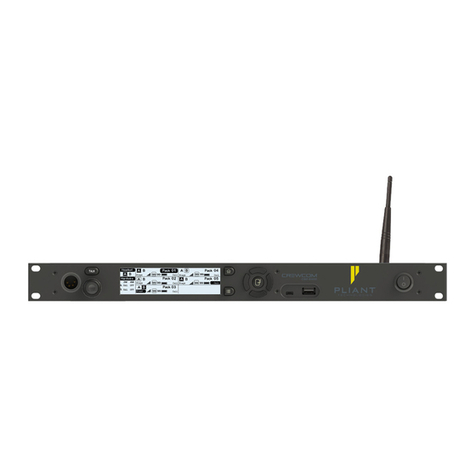
Pliant
Pliant CREWCOM operating manual
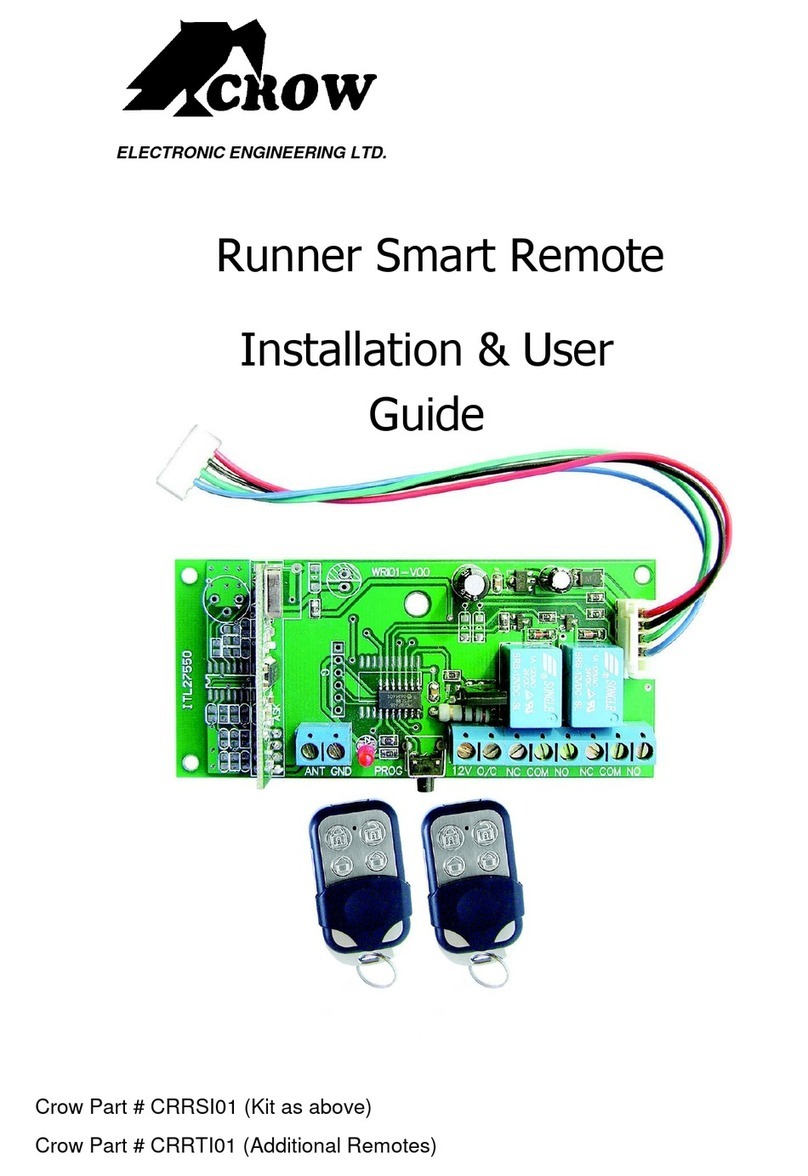
Crow
Crow CRRSI01 Installation & user guide

Mitsubishi Electric
Mitsubishi Electric FX-USB-AW user manual

Pentair
Pentair Anderson Greenwood 93 Series Installation and maintenance instructions

RAYLASE
RAYLASE SP-ICE-1 PCI/e PRO Hardware manual

